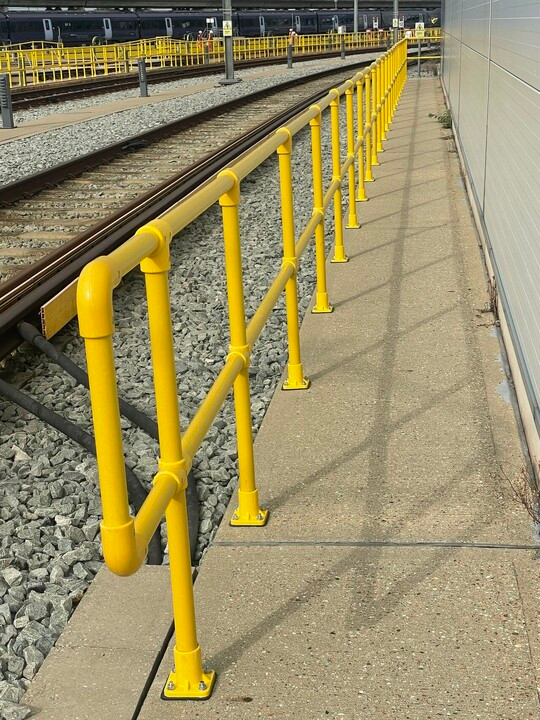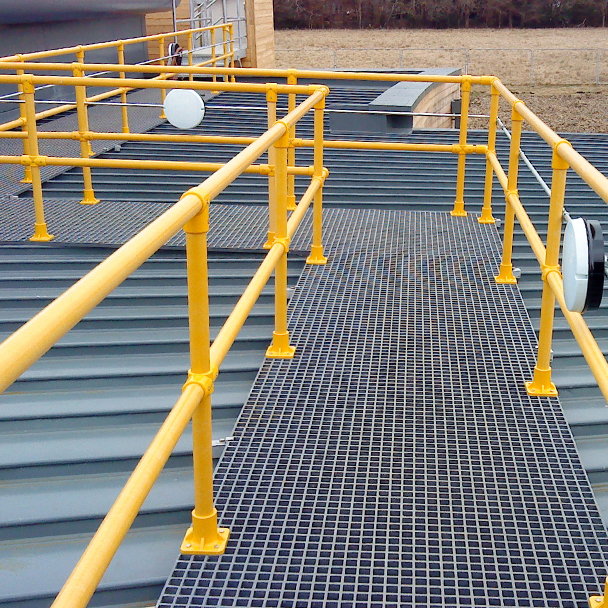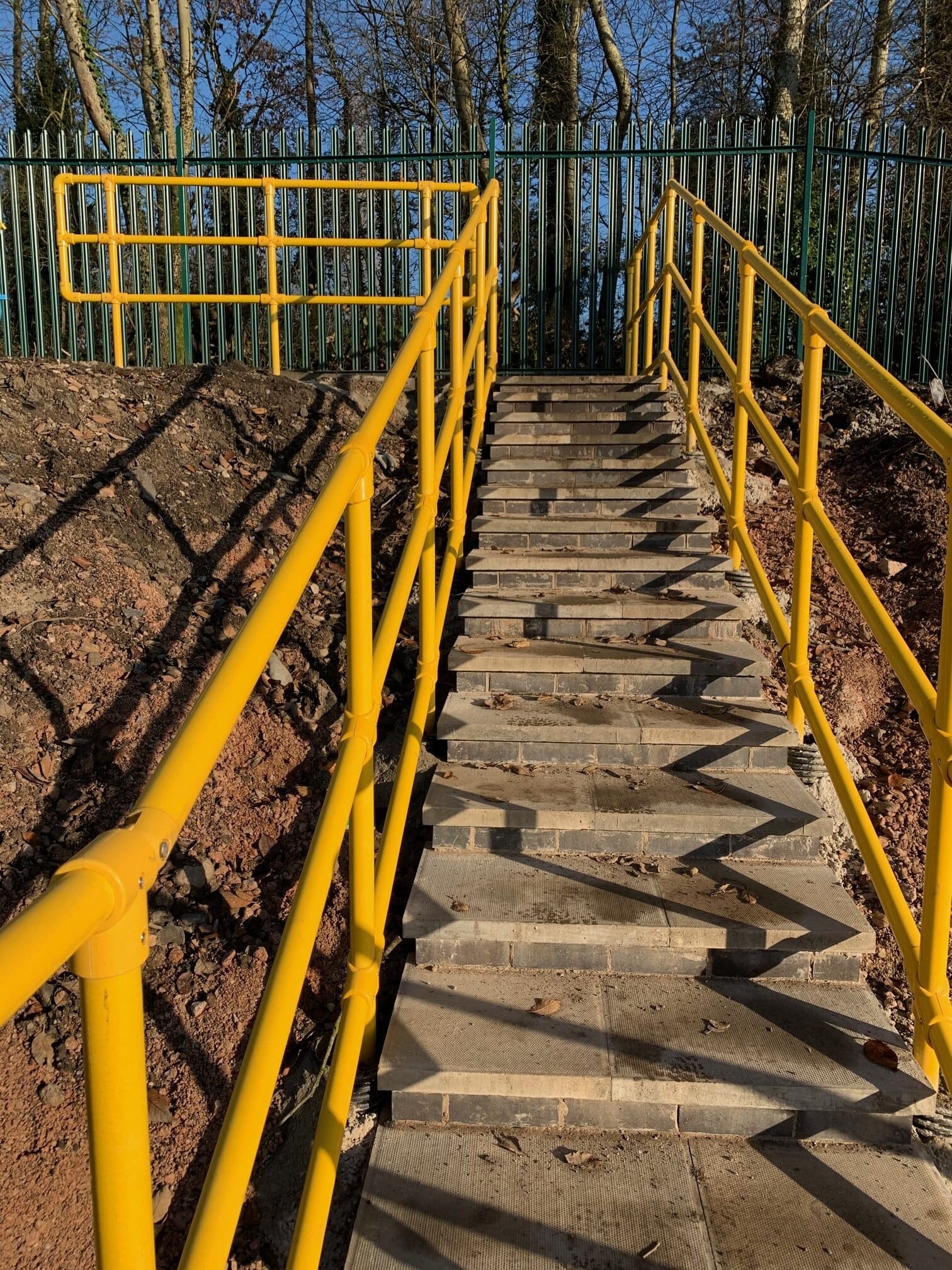หนึ่ง FRP (Fiber-Reinforced Plastic) Rail Platform is a specialized platform designed for use in environments where corrosion resistance, lightweight properties, and high strength are critical. These platforms are primarily used in industries where rail-based transportation is essential, such as railways, subways, industrial rail tracks, และ offshore platforms. FRP Rail Platforms are made from advanced composite materials, combining fiberglass with resin to produce a product that is strong, light, and highly resistant to harsh environmental conditions.
การแนะนำประสิทธิภาพของผลิตภัณฑ์
This document provides a detailed overview of the FRP Rail Platform, including its physical properties, specifications, advantages, disadvantages, และ common applications.
1. Physical Properties of FRP Rail Platforms
1.1. Strength and Durability
-
อัตราส่วนความแข็งแรงต่อน้ำหนักสูง: FRP platforms offer a high mechanical strength while being much lighter than traditional materials like steel. This results in easy handling, transportation, and installation.
-
Load-Bearing Capacity: These platforms can support substantial loads while remaining durable and resistant to heavy impacts, making them ideal for use on railways and heavy transport systems.
1.2. Corrosion and Chemical Resistance
-
ความต้านทานการกัดกร่อน: FRP is highly resistant to rust, corrosion, and degradation due to exposure to harsh weather, moisture, and chemicals. This makes it ideal for marine environments, chemical plants, and areas exposed to saltwater or acidic conditions.
-
ทนต่อสารเคมี: FRP materials are often tailored with specific resins (like vinyl ester or อีพ็อกซี่ resins) that offer high chemical resistance, ensuring that the platforms will not degrade in the presence of harsh chemicals commonly found in industrial settings.
1.3. Fire Resistance
-
FRP Rail Platforms can be made with fire-retardant resins that meet various fire safety standards. These platforms are specifically formulated to minimize the risk of flame propagation, emitting low smoke and toxic gases when exposed to heat, making them safer for use in environments with fire hazards.
1.4. Electrical and Thermal Insulation
-
ที่ไม่นำไฟฟ้า: FRP is inherently non-conductive, which means that it provides safety in high-voltage environments. This makes it ideal for use around electrical equipment and in locations like power substations or railway signal systems.
-
ฉนวนกันความร้อน: FRP also offers low thermal conductivity, meaning it does not transfer heat or cold quickly, making it more comfortable and safer for workers and passengers.
2. Specifications of FRP Rail Platforms
2.1. Standard Dimensions and Customization
-
ความหนา: Typically ranges from 25mm to 50mm, but customized thicknesses are available for specific load-bearing needs.
-
Panel Sizes: Common sizes for FRP Rail Platforms include 1m × 1m, 1.2m × 2.4m, or fully customized dimensions.
-
Load Capacities: Customizable to handle a wide range of loads, with typical values ranging from 500 kg/m² ถึง 10,000 kg/m² depending on the design and reinforcement type.
-
Customizable Features: FRP Rail Platforms can be designed with specific features, such as cutouts, handrails, integrated drainage, และ anti-slip surfaces for added safety and functionality.
2.2. Material Composition
-
การเสริมแรงด้วยไฟเบอร์กลาส: The platform is reinforced with E-glass or S-glass fibers for general-use strength, or carbon fiber for heavier load-bearing applications.
-
ชนิดของเรซิน: Various resins can be selected based on the desired properties:
-
Polyester Resin: Cost-effective, general-purpose resin.
-
ไวนิลเอสเตอร์เรซิน: Offers high chemical and temperature resistance.
-
อีพอกซีเรซิน: Provides superior mechanical strength and durability.
-
เรซินฟีนอลิก: Used for applications requiring enhanced fire resistance and low smoke emission.
-
2.3. Mechanical Properties
| คุณสมบัติ | Typical Value |
|---|---|
| ความต้านแรงดึง | 300-800 MPa |
| ความแข็งแรงในการดัดงอ | 250-700 MPa |
| ความแข็งแรงในการบีบอัด | 300-850 MPa |
| ความหนาแน่น | 1.7-2.2 g/cm³ |
| Modulus of Elasticity | 25-45 GPa |
3. Advantages of FRP Rail Platforms
3.1. ความต้านทานการกัดกร่อน
-
One of the key advantages of FRP Rail Platforms is their exceptional resistance to corrosion, making them ideal for use in marine or chemical processing environments. These platforms do not degrade when exposed to saltwater or industrial chemicals, ensuring a long lifespan and reduced maintenance.
3.2. น้ำหนักเบาและติดตั้งง่าย
-
น้ำหนักเบา: FRP Rail Platforms are much lighter than steel (up to 75% lighter), which reduces the need for heavy machinery during installation and makes transportation easier and more cost-effective.
-
Quick Installation: The modular design allows for quick assembly and installation, saving time and reducing labor costs. It is easier to modify or expand platforms without disrupting ongoing operations.
3.3. Customizable Design
-
FRP Rail Platforms are highly customizable, which allows for tailored dimensions, load-bearing capacities, และ surface finishes. Users can choose from various finishes, including anti-slip surfaces, to enhance safety, particularly in environments where moisture or other hazardous conditions are present.
3.4. Non-Conductive and Safe
-
Since FRP is non-conductive, these platforms provide a safe working environment in locations with electrical hazards. They are commonly used in power plants, railway signaling systems, และ high-voltage stations, providing workers with protection from electrical accidents.
3.5. ความทนทาน
-
การบำรุงรักษาต่ำ: FRP Rail Platforms require minimal maintenance as they do not rust, rot, or degrade like traditional materials such as wood and steel.
-
Long Lifespan: With high resistance to environmental elements, these platforms have a long operational life and offer cost savings over time.
3.6. Fire Safety
-
FRP Rail Platforms made from fire-resistant materials offer increased safety in environments where fire hazards are prevalent. They can meet various safety standards, including low smoke emissions, ensuring compliance with fire safety regulations.
4. Disadvantages of FRP Rail Platforms
4.1. Higher Initial Costs
-
ที่ upfront cost of FRP Rail Platforms may be higher than traditional materials such as steel or wood. However, the long-term savings due to reduced maintenance and longer lifespan often make FRP a more cost-effective option in the long run.
4.2. Limited Heat Resistance
-
FRP materials begin to degrade at temperatures above 200°C, limiting their application in environments with high heat, such as furnaces or high-temperature areas.
4.3. Recycling Issues
-
FRP materials are difficult to recycle due to their composite nature. This could be an environmental concern at the end of the product's lifecycle.
4.4. Potential for Brittleness
-
In extreme cold conditions, FRP platforms may become more brittle and prone to cracking, particularly when subjected to sharp impacts or heavy loads.
5. Applications of FRP Rail Platforms
5.1. Rail and Transit Systems
-
Railway Stations: FRP platforms are used to create lightweight, durable, and corrosion-resistant platforms for railway stations และ subway systems.
-
Maintenance Platforms: Used in railway maintenance depots, where platforms must withstand heavy loads and provide safe working conditions.
5.2. Marine and Offshore Applications
-
Docks and Shipyards: Due to their resistance to saltwater และ moisture, FRP Rail Platforms are perfect for use in marine environments where traditional materials are prone to corrosion.
-
Offshore Oil Rigs: These platforms are used to provide safe and stable working conditions on offshore rigs and platforms.
5.3. โรงงานอุตสาหกรรม
-
โรงงานเคมี: The chemical resistance of FRP platforms makes them ideal for use in chemical processing plants, where exposure to harsh chemicals is common.
-
โรงไฟฟ้า: These platforms can be used for maintenance walkways และ service areas in power generation facilities.
5.4. โครงสร้างพื้นฐานสาธารณะ
-
Pedestrian Walkways: FRP Rail Platforms are often used in public spaces like parks, stadiums, และ transit stations, providing slip-resistant surfaces for pedestrian safety.
-
Bridges and Overpasses: Due to their lightweight nature, FRP platforms can be utilized in bridge construction และ overpasses.
FRP Rail Platform
ชุด :
ผลิตภัณฑ์หลัก >แอปพลิเคชัน
Industrial Plants and Chemical Factories Offshore Platforms and Marine Environments Water and Wastewater Treatment Facilities Power Plants and Substations Public Transport Stations and Pedestrian Bridges Construction Sites and Warehouses
ชื่อแบรนด์ :
ทีเอฟคอมโพสิต
ชื่อผลิตภัณฑ์ :
FRP Walkways
วัสดุ :
ไฟเบอร์กลาส
สี :
Yellow,Other
คำถามที่พบบ่อย
ถาม :
What are FRP Walkways?
ตอบ :
FRP Walkways are walkways made from fiber-reinforced plastic materials, combining fiberglass and resin to offer strength, corrosion resistance, and lightweight properties. They are used in various industrial, commercial, and public infrastructure applications.
ถาม :
How strong are FRP Walkways?
ตอบ :
FRP walkways are designed to support varying loads, with typical capacities ranging from 500 kg/m² to 10,000 kg/m², depending on the material used and design specifications.
ถาม :
Can FRP Walkways be used in outdoor environments?
ตอบ :
Yes, FRP walkways are perfect for outdoor use, particularly in environments exposed to moisture, saltwater, and extreme weather conditions. However, UV-resistant coatings may be necessary to ensure long-term performance under direct sunlight.
ถาม :
Are FRP Walkways fire-resistant?
ตอบ :
Yes, FRP walkways can be made with fire-retardant resins (such as phenolic or vinyl ester resins) to meet fire safety standards. These materials produce low smoke emissions and are ideal for environments that require enhanced fire safety.
ถาม :
What customization options are available for FRP Walkways?
ตอบ :
FRP walkways can be customized in terms of size, shape, color, load capacity, surface texture (e.g., anti-slip), and integrated features like cutouts, drainage holes, and handrails to meet specific application requirements.
ถาม :
Are FRP Walkways suitable for heavy-duty applications?
ตอบ :
Yes, FRP walkways are available in heavy-duty versions capable of supporting extremely high loads, making them suitable for environments such as offshore oil rigs, steel mills, and chemical plants.
สินค้าอื่นๆที่เกี่ยวข้อง














